Buck Rogers first appeared as Anthony Rogers in a short space opera, “Armageddon-2419 A.D.” by Philip Francis Nowlan, published in the August 1928 issue of Amazing Stories. A sequel, “The Airlords of Han,” appeared in the March 1929 issue. The warlike Hans were later changed to Mongols in subsequent printings.
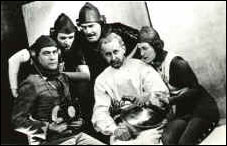
Concurrent with these novels, Buck appeared in a comic strip that ran in several American newspapers from 1929 until the late 1930s. Sponsors soon transferred the story to a radio serial that first aired on 7 Nov 1932. These radio shows appeared on random occasions until they enjoyed a full series in 1938-39.
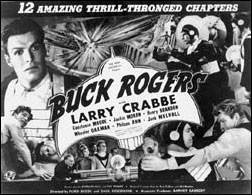
Buck’s early popularity peaked when Olympic swimmer turned actor, Larry “Buster” Crabbe portrayed the hero in a famous film serial in 1939 (while concurrently playing the serial hero Flash Gordon). Buck became an American icon overnight. Just as suddenly, his legend, like his character, fell into a deep sleep that remained until it wasrevived with a new radio drama series in 1947.
The 1939 film serial was edited into a feature film and re-released as a theatrical release in 1953 as “Planet of Outlaws”. It was released to television in 1965 as “Destination Saturn”.
In the comic strip, radio dramas, and film series, Buck was a man of our time who suffered an accident and subjected to a mysterious gas that held him in suspended animation until he was discovered in the 25th century.
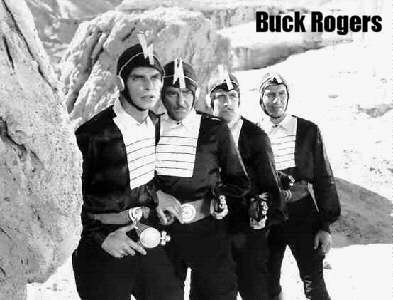
He was resuscitated by the good inventor and scientist Dr. Huer. The Doctor had an assistant who was a Lieutenant in the Space Corp, Wilma Deering. Buck was quick to adapt to the marvelous inventions and ways of the future and set off on adventures against space villains with the help of Wilma and other space friends such as Black Barney, a dense Martian pirate turned sometimes sidekick. Buck and his friends from the future battled evil forces led by Killer Kane and Ardala Valmar, who thieved Earth technology and plotted the destruction of Earth from the adversarial planet, Saturn. The Earthlings employed fabulous devices including death rays, incendiary missiles, gamma bombs, degravity belts, and a mechanical mole capable of burrowing deep into the Earth. Unlike the later Gil Gerard series, the earlier versions included a sidekick, Buck’s youthful and sometimes uncertain pal, Buddy Wade.
The early incarnations of Buck Rogers were products of their time, infused with uncertainty over the depression and impact of the “New Deal” and heavily entrenched suspicions of all things eastern. Memories of the Chinese Boxer rebellion still resounded in US politics and daily life and this spilled into fantasy entertainment until the end of WWII when varied forms of the Nazi party became the new source for villains.
Following the cancellation of his 1978 hit series Battlestar Galactica, Glen Larson brought new life to the series with a theatrical movie released to theaters on 30 Mar 1979. The film showed enough interest to warrant the continuation of a full series that aired on 20 Sept. of the same year.
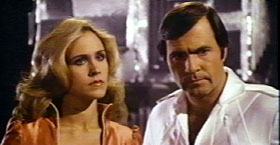
Although sharing the basic elements of the original cliffhangers, Larson’s version, staring Gil Gerard and Erin Gray, veered from the original themes. Princess Ardala returned to threaten Earth but the conflict was now one of starfighters and fist fights. The new Buck was a spy and action hero who was constantly surrounded by beautiful women, blinking lights, tongue-in-cheek dialog. The scripts were silly, but the show had its own special charm.
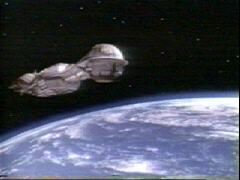
It didn’t maintain the audience that studio execs demanded. Buck was kept for a second season but the format was revamped into a show that more closely resembled Star Trek. In the second season, Buck, Wilma, and Twiki joined the crew of the starship “Searcher” commanded by Admiral Asimov. Its mission was to locate the lost tribes of Earth, humans who fled their home world after the nuclear holocaust.
Among this crew was a snobbish robot that served practically no purpose whatsoever. The humans are later joined by Hawk, a birdman whose people were nearly wiped out by humans.
Buck didn’t survive to the third season.
The Buck Rogers used revamped sets and props from Larson’s then-cancelled 1978 Battlestar Galactica series, as well as certain actors, a handful of effects shots, scores of sound effects, and retained a large portion of its viewer base. Similarly, the bulk of the production staff remained the same for both television series.
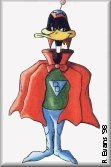
Although the concepts of Buck have been imitated many times, the most direct flattery for the Buck Rogers legend came from Warner Brothers in the 1953 spoof cartoon, Duck Dodgers in the 24th 1/2 Century and two sequels, one in 1980 and 1996. When ‘Duck’ (played by Daffy Duck) battled to save the Earth from his evil foe, who was played by Marvin the Martian.
In September, 2002 Duck Dodgers returned in his own animated series in which Duck is accidentally frozen in the 21st century and is thawed out 351 years later. He convinces the Earth’s Defensive Protectorate that he is a hero from the 21st century and with a Starship and crew sets out to save the Earth from Martian Commander X-2, again played by Marvin the Martian.